Dipole vs Bipole Speakers: What’s the Difference?
There seems to be some confusion when it comes to dipole vs bipole speakers. While I won’t dive into everything on that topic, the issue of bipole (bi-pole, bi-polar) surrounds vs. dipole (di-pole, di-polar) surrounds arises enough to make us want to clarify the topic for readers and home theater enthusiasts. If you want to understand the differences between bipole and dipole speakers, you’ve come to the right place.
First, some background on these two technologies. It’s important to note that the terms “dipole” and “bipole” don’t necessarily retain their technically accurate definitions in reality. What I mean by that is a technical definition of a bipole speaker may not match many speakers labeled as being “bipole” that are sold in today’s market.
Let’s Address Dipole Speakers First
The strict definition of a dipole speaker is a speaker enclosure in which the speaker radiates or projects sound forward, and the reverse polar response is 180 degrees out of phase. You get the simplest dipole speaker by mounting a driver onto an open baffle. The speaker fires in-phase on the front side of the baffle, and 180 degrees out of phase on the backside of the baffle. Out of phase means that if a drawn version of the waveform has a peak on the front of the speaker, the rear speaker would be issuing the same level of the waveform as a trough.
A dipole speaker generates the same amount of SPL output from the front and back of the speaker, but the sounds are electrically out of phase with each other.
Of course, this doesn’t describe most of the dipole speakers you find today. Dipole now more loosely pertains to a speaker with two sets of drivers that fire out of phase with each other, even if those drivers aren’t oriented perfectly opposite each other. That means that a speaker whose drivers fire outwards at 90 degrees is still considered a dipole speaker—at least as far as surround sound speakers are concerned. When you have speakers firing out in opposite phase like that, the sounds cancel out in the center, leaving a null in the middle. When you “point” the middle of a surround speaker at the listening position, it creates a rather diffuse sound. This is more in line with what the re-recording engineers desire for their surround effects and ambient sounds.
How to Remember the Difference Between Dipole vs Bipole Speakers: With a bipole speaker “b”oth driver pairs are firing in-phase with each other. With a dipole speaker, the drivers are firing in “d”ifferent phase from each other. Dipole speakers are more “d”iffuse because they create a null at the listening position. If that doesn’t help you remember, nothing will!
That world is slowly changing as sound designers and re-recording mixers of feature film soundtracks get to use more specific point-source technologies like Dolby Atmos. Even with new technology dawning, surround sound speakers still remain very effective when they aren’t completely localizable by the listener.
Bipole Speakers Offer an Interesting Hybrid Approach for Listening
Bipole surround speaker utilizes drivers which are wired in phase with the opposite pair. That means that a bipole speaker creates a diffuse sound, but lacks the dramatic null of a dipole speaker whose drivers are wired at least partially out of phase with one another. When the sounds of both drivers in a bipole speaker converge, they don’t cancel each other out. In a dipole configuration, the central area of the speaker gets a diffuse sound caused by the off-axis summed response of the two in-phase drivers.
If you listen to a lot of music, or you can’t position the speakers exactly perpendicular to the listening position, then bipole speakers are for you. They produce excellent diffuse sound when placed on a rear wall, and they are my go-to choice when I can’t get the exact placement I need in a home theater.
Conclusion
If you’re really geeky, you might want to know what’s going on inside of the speakers themselves. For those few, I have this simple wiring chart. It oversimplifies things a bit, but should be helpful in understanding the basic concept.
Do you have plans to upgrade your surround speakers? If so, have you decided on dipole vs bipole speakers? What criteria did you feel was the most important? Let us know in the comments below and Follow us on our Facebook page for even more tips and tricks.

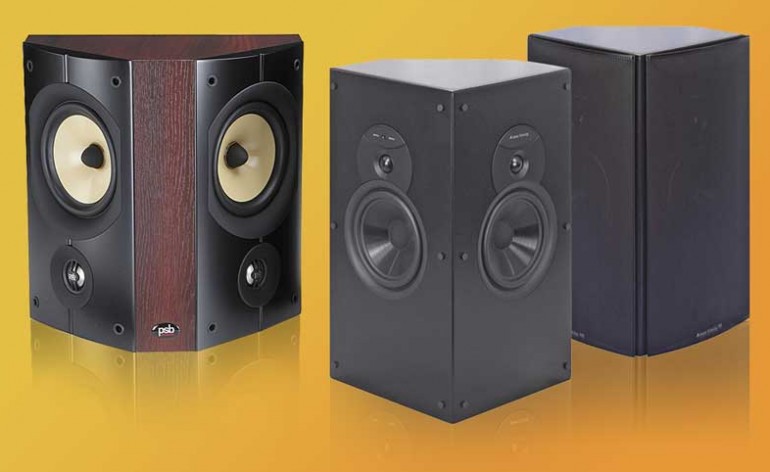
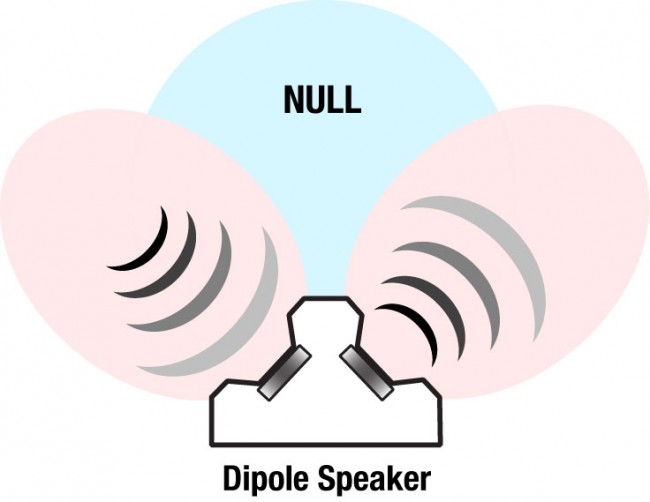

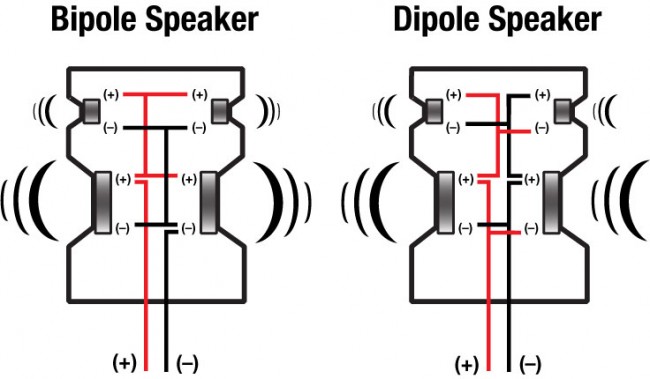
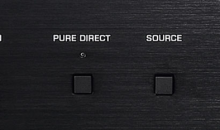


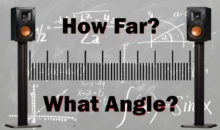

Are you getting bipole and dipole mixed up in
“You get the simplest bipole speaker by mounting a driver onto an open baffle”
and
“In a dipole configuration, the central area of the speaker gets a diffuse sound caused by the off-axis summed response of the two in-phase drivers”
What about combining Dipole and Bipole Speakers on a 7.1 System…..? Lets say Dipoles on the Sides and Bipole on Back? Is that a good combination or they all should be the same? I hear a lot of 2-ch Stereo music mostly on a 2.1 setup, but like to watch Concerts on a 7.1 setup.
I really like Clint’s common sense approach to this home theatre stuff. There is an awful lot of overpriced nonsense out there, but for good advice I end up here.
In the sentence “In a dipole configuration, the central area of the speaker gets a diffuse sound caused by the off-axis summed response of the two in-phase drivers” shouldn’t it say “In a bipole configuration, …?
“How to Remember the Difference Between Dipole vs Bipole Speakers: With a bipole speaker “b”oth driver pairs are firing in-phase with each other. With a dipole speaker, the drivers are firing in “d”ifferent phase from each other. Dipole speakers are more “d”iffuse because they create a null at the listening position. If that doesn’t help you remember, nothing will!”
In a dipole configuration, because the two drivers are 180° out of phase with each other, the two opposites cancel each other in the center of the listening area. That’s why the diffuse effect is more dramatic.
Couldn’t agree more!
Hi,
I have the Kef Reference 206/2ds, I always thought looking at the documents that they are dipools but problem is placing them correct. Know there should be a switch that makes them bipools witch should easier to install and use them. But is there a switch on the back of the Kef Reference 206/2ds?
Regards,
Jürgen
My Cambridge sound works surrounds have a simple switch to select di or bi
Yep, that is quite common!
THX Dipoles were my invention (you’ll hear other stories elsewhere, but it is in the sense of the original patent). Wide range dipoles do lose low frequency output because of cancellation, but THX ones revert to monopole at low frequencies to maintain headroom. They are required to produce the null expected by 315 Hz and above. The one installation I made in a Hollywood studio with both monopoles and dipoles switchable in a blind a/b showed the monopole better at hearing clicks, bu the dipole much superior spatially. Pans from front were smoother. Envelopment was greater. This is hard to do because the systems have to match in level and frequency response closely. But everyone at that major studio agreed, and they qc’ed on the monopoles and listened on the dipoles.